Semispinalis Muscle Anatomy
Table of Contents
What is the Semispinalis muscle?
- The semispinalis muscle relates to the transversospinalis muscles. The transversospinalis muscle group is a very deeper layer of muscles situated on either side of the spine.
- The semispinalis muscle is:
- The most superficial/upper layer of this muscle part.
- The bigger muscle mass is in the posterior part of the neck.
- It is responsible for maintaining posture or for movement of the head or the vertebral column.
- It has the largest fascicles of the transversospinalis group, spanning 6 segments.
Anatomy Semispinalis Muscle
The muscles in this grouping are the semispinalis capitis, semispinalis cervicis, or semispinalis thoracic.
- Semispinalis capitis muscle – locates superficial to the semispinalis cervicis muscle or deep to the splenius capitis or cervicis or trapezius muscle.
- Semispinalis cervicis muscle – fascicles surfaced the cervical or thoracic multifidus muscles
- Semispinalis thoracis muscle – thin, fleshy fascicles with long tendons at their end. It surfaced the thoracic multifidus muscle
- Arising point: T6 to T10 transverse processes
- Ending Point: C6 to T4 spinous processes
Deep Intrinsic Back Muscles
- Deeper Muscles of the back
- The Semispinalis muscles relate to the intrinsic/ deeper muscles of the back. These muscles are well-created or collectively extend from the sacrum to the base of the skull. They are considerate with the motions of the vertebral column or the control of posture.
The deep muscles of the back are further divided into three groups
- Superficial,
- Intermediate or
- Deep layers.
- Transversospinales muscle group locates deeper to the Erector Spinae.
- It consists of three major further groups:
- Semispinalis,
- Multifidus
- Rotatores.
Semispinalis Capitis Muscle
What is Semispinalis Capitis Muscle?
- Semispinalis capitis is a longer paired muscle that relates to the deeper layer of muscles of the back. It creates the superior, or largest, component of the 3-part semispinalis muscle. With semispinalis cervicis or semispinalis thoracis creating the middle or inferior divisions of the muscle, respectively. There is no lumbar spine differentiation for the semispinalis muscle.
- The semispinalis muscle is located lying on either side of the vertebral column spanning from the occipital bone to as far as the 10th thoracic vertebrae. Of the 3 components, thoracis situates the most medially or the capitis the most laterally.
- Combine with the semispinalis, multifidus, or rotatores muscles comprise the deeper (transversospinal) layer of the back muscles. These muscles took part in the extension, lateral flexion, or rotation of the head, and cervical or thoracic spine.
Structure and Variations of the semispinalis Capitis Muscle
- Semispinalis capitis spans the neck or upper back regions as it travels from the cervical or thoracic vertebrae to the occipital bone. Its muscle tendons start from the articular processes of vertebrae C4 to C7 or the transverse processes of vertebrae T1 to T6. From these joining tendons, the muscle fibers of semispinalis capitis diverge into a single muscle belly that travels superiorly across the lateral side of the vertebral column. The muscle ends in the occipital bone, between superior or the inferior nuchal lines or the posterior to the ending of obliquus superior, rectus capitis posterior major, or rectus capitis posterior minor muscles.
- The outer surface of semispinalis capitis is surfaced by splenius capitis muscle, while its inner surface over shadow semispinalis cervicis muscle. Semispinalis muscles are found medial to the longissimus muscle, which consists of the central cord of the erector spinal muscle.
- Synonyms: The Medial branch of the posterior ramus of spinal nerve C2, and Nerve of Arnold.
- Semispinalis capitis muscle collects its innervation via the greater occipital nerve (posterior ramus of C2 spinal nerve) or the spinal nerve C3. Arterial supply comes from the occipital artery that starts from the external carotid artery.
- Regarding function, semispinalis capitis helps obliquus capitis superior, splenius, trapezius, rectus capitis posterior major, or the rectus capitis posterior minor muscles to extend the head, cervical, or the thoracic spines. Unilateral contraction however results in ipsilateral lateral flexion of the head, cervical or thoracic spine, & the contralateral rotation of the head, cervical & thoracic spine.
Origin
- The muscle arises from the articular processes of the C 5, 6, 7, & 8 as well as the transverse processes of T 1, 2,3,4,5, & 6.
Insertion
- The semispinalis capitis joins into the occiput in between the superior or the inferior nuchal line.
Nerve Supply
- The nerve supply of the semispinalis capitis muscle is the greater occipital nerve, which is additionally nerves supplied to the scalp.
Blood Supply
- The vascular supply of the semispinalis capitis descending branches of the occipital artery or the superior intercostal artery, through the dorsal rami of the upper 2 posterior intercostal arteries.
Action
- It works bilaterally: Extension of the head or the neck.
- It works unilaterally: Rotation of the head or the neck to the opposite side
The function of semispinalis Capitis Muscle
- During bilateral squeezing, this muscle is termed as a primary mover for dynamically maintaining the cervical lordosis it is considered 1 of the primary factors in preserving the balance of the head on the neck.
Clinical Significance of Semispinalis Capitis Muscle
- The semispinalis capitis is the biggest muscle in the posterior neck. The semispinalis cervicis or the capitis locates deeper in the upper trapezius.
- Muscle pain that arises from this region is generally misdiagnosed as a trapezius injury when it is a semispinalis problem.
- The greater occipital nerve (nerve supplies to the posterior scalp) pierces via the semispinalis capitis (as well as the upper trapezius). Occipital neuralgia may on occasion be created by entrapment of the greater occipital nerve in the penetration site of the semispinalis capitis.
Semispinalis Cervicis Muscle
What is Semispinalis Cervicis Muscle?
- Semispinalis cervicis is a muscle of the back. Together with the semispinalis capitis or the thoracis it consists of a long semispinalis muscle. This muscle relates to the spin transverse group of deeper back muscles, together with the rotatores or the multifidus muscles.
- The primary anatomical feature of the semispinalis muscle, & of the semispinalis cervicis, is that it joins between the spinous or the transverse processes of vertebrae, bridging 5 to 6 vertebral levels with its course.
- Semispinalis cervicis works in synergy with its capitis or the thoracis counterparts. Their conjoint function enhances the motions of the vertebral column; extension, lateral flexion, or the rotation of the head, cervical or thoracic spines.
Structure and Variations of the Semispinalis Cervicis Muscle
- Synonyms: Semispinalis Colli muscle, Musculus semispinalis colli
- Semispinalis cervicis begins from the transverse processes of vertebrae T1 to T6. The slender fascicles of this muscle course over the thoracic or the cervical regions of the back to finally end into the posterior surfaces of spinous processes of vertebrae C2 to C5. The muscle fibers course in a laminated fashion so that those arising from the T1 end in the C2, while those stemming from the T6 end in the C5.
- The dorsal & the lateral aspects of the semispinalis cervicis locates deeper in the semispinalis capitis muscle. On its aspects, the muscle surfaced the dorsal surface of multifidus cervicis or the thoracic muscles, while medially are the bodies of cervical or the thoracic vertebrae. Semispinalis cervicis is a nerve supplied by the medial branches of posterior rami of spinal nerves, while its blood supply arrives from the occipital, deep cervical, or vertebral arteries.
Origin
- Transverse processes of T1 to T6, and the articular processes of the fourth to seventh cervical vertebrae
Insertion
- It ends with the Spinous processes of C2 – C5
Nerve Supply
- The Semispinalis Cervicis Muscle nerve supplied by the Dorsal rami of cervical spinal nerves
Blood Supply
- The Semispinalis Cervicis Muscle vascular supplied by the Deeper cervical artery
Action
- It works bilaterally: extension of the cervical spine
- It works unilaterally: lateral flexion of the neck or the rotation to the opposite side.
The function of Semispinalis Cervicis Muscle
- The function of semispinalis cervicis is to assist the head & neck extensors to extend the head at the neck when working bilaterally. On the other hand, its unilateral contraction work on the same muscles to perform the ipsilateral lateral flexion or the contralateral rotation of the head, cervical & thoracic spines.
Clinical Significance of Semispinalis Cervicis Muscle
- The semispinalis capitis is the biggest muscle in the posterior neck. The semispinalis cervicis or the capitis locates deeper into the upper trapezius.
- Muscle pain that is produced from this region is normally wrong diagnosed as a trapezius injury when it is a semispinalis problem.
- The greater occipital nerve (nerve supplied to the posterior scalp) penetrates through the semispinalis capitis (as well as the upper trapezius).
- Occipital neuralgia may on rare be created by entrapment of the greater occipital nerve in the perforation location of the semispinalis capitis
Semispinalis Thoracis Muscle
What is Semispinalis Thoracis Muscle?
- Semispinalis are a group of back muscles that combine with the rotatores or the multifidus to comprise the transversospinalis group of deeper back muscles. The Semispinalis group is situated placing on either side of the vertebral column spanning from the skull as far as to the vertebra T10. These muscles are further divided regionally into the semispinalis capitis, cervicis, or the thoracis.
- Semispinalis thoracis consists of the 5 fascicles bridging over 5 to 6 vertebral levels between the transverse or the spinous processes of certain cervical or thoracic vertebrae. With these joining, semispinalis thoracis aids several motions of the vertebral column; specifically extension, lateral flexion, & rotation of the thoracic spine. Working together with semispinalis capitis or the cervicis, it assists the same motions occurring at the head or the neck.
Structure and Variations of the Semispinalis Thoracis Muscle
- Synonyms: Thoracic semispinalis muscle
- Semispinalis thoracis consists of 5 muscle fascicles that respectively begin from the transverse processes of 5 consecutive vertebrae; T6 to T10 levels. After a short superior course, these thin fibers come together, comprising a single muscle belly that continues its way toward the upward thoracic levels.
- At the C6 vertebral level, it begins giving off tiny muscle slips that successively end into the spinous processes of vertebrae C6 to T4. This type of laminar arrangement often seems in the muscles of the back or it means that the fibers with the lowest vertebral level of starting (T10) have the lowest vertebral level of ending (T4).
- This muscle locates medial to the erector spinae muscle group or lateral to the cervical or thoracic vertebrae. Sitting deeper to semispinalis thoracic is the rotatores or the lavatories costarum, while superficially it is surfaced by the spinalis thoracis (erector spinae group). Just like all the transversospinalis muscles, the semispinalis thoracis is a nerve supplied by the medial branches of the posterior rami of adjacent spinal nerves. The dorsal branches of the posterior intercostal arteries give their vascular supply.
Origin
- It arises from the spinous processes of T11 to L2.
Insertion
- It ends with the spinous processes of T2 to T8.
Nerve Supply
The spinal thoracic muscle is the nerve supplied by the Spinalis Thoracis the Lateral branch of the posterior rami of spinal nerves
Blood Supply
- The blood supply to the semispinalis thorcis is by the Posterior branch of the posterior intercostal artery, deep cervical artery, or the muscular branches of the vertebral artery.
The function of Semispinalis Thoracis Muscle
- Synonyms: Extension cervicis
- Semispinalis thoracis muscle rarely works alone but rather in synergy with its capitis or the cervicis counterparts, or with other extensors of the neck or the spine. Depending on whether it squeezes unilaterally or bilaterally, the functions of this muscle are;
- Extension of the head at the neck or the extension of the cervical & the thoracic spine at intervertebral joints;
- When it contracting bilaterally Lateral flexion of the head, cervical, or the thoracic spine on the same side of the rotation of the head, cervical & the thoracic spine on the other side; unilateral contraction
Clinical Significance of Semispinalis Thoracis Muscle
- The semispinalis capitis is the biggest muscle in the posterior neck. The semispinalis cervicis or the capitis locates deep in the upper trapezius.
- Muscle pain that emanates from this area is often a misconception as a trapezius injury when it is a semispinalis problem.
- The greater occipital nerve (supplied by the posterior scalp) pierces via the semispinalis capitis (as well as the upper trapezius). Occipital neuralgia may on rare be created by entrapment of the greater occipital nerve in the perforation position of the semispinalis capitis.
Stretching Exercise for Semispinalis Muscle
Semispinalis capitis muscle stretch
- The semispinalis capitis muscle (of the transversospinalis group) is stretched by flexing the head & the neck at the spinal joints.
- Adding in lateral flexion (not seen in the accompanying illustration) will raise the efficacy of the stretch for the other-side semispinalis capitis muscle.
- You can hold for 30 secs & the three reps.
Semispinalis cervicis muscle stretch
- The right side semispinalis cervicis muscle is stretched by flexing, the left laterally flexing, & the left side rotating the neck at the spinal joints, while the right side of the shoulder girdle is allowed to raise.
- You can hold for 30 secs & the three reps.
Table Semispinalis Stretch
- Sitting in front of a table.
- Keep the chin in & down throughout this stretch.
- Place the left side fist on the left side of the chin.
- Place the left side elbow onto the table in front of you.
- Rest the weight of the head onto your fist.
- Tilt the head to the left side.
- Apply more pressure to the chin to gear up the stretch.
- The goal is to feel a firm stretch on the right side of the Semispinalis muscle of the neck.
- Hold for 30 secs.
- Perform on the alternate side.
Basic Semispinalis Stretch
- Tuck the chin in & downwards.
- Tilt the head to the right side.
- Put the right side hand on the opposite side of the head.
- Apply downward compression.
- Slowly turn the head to the left side.
- The goal is to feel a firm stretch in the left side of the Semispinalis muscle.
- Hold for 30 secs, 3 rep.
- Repeat on the alternate side.
Semispinalis Stretch Variation
- Place the fingers on top of the left side collar bone.
- Pulling the skin down.
- Tuck the chin in & down.
- Slowly turn the head towards the left side.
- Tilt the head towards the right side.
- The goal is to feel a stretch on the left side of the Semispinalis muscle.
- Hold for 30 secs, 3 rep.
- Repeat on the alternate side.
Chair Lean Stretch
- Sitting down on a chair.
- Using the right side hand, grab onto the side of the chair.
- Keep the shoulder completely relaxed.
- Leaning the body completely towards the left side.
- Tuck the chin in & downwards.
- Tilt the head towards the left side.
- Place the left hand on the right side of the head.
- Apply downward compression.
- The goal is to feel a stretch on the right Semispinalis muscle of the neck.
- Hold for 30 secs, 3 rep.
- Repeat on the alternate side.
Neck Elongation Stretch
- Tuck the chin in & downwards.
- Slide the head towards the right side.
- Elongate the right side of the neck in an upwards direction.
- The goal is to feel a stretch on the right side of the neck.
- Repeat on the alternate sides.
- Perform 30 reps, 3 rep.
Strengthening Exercise For Semispinalis Muscle
Semispinalis capitis exercises
Neck retraction exercises
- Sit on soft ground or a chair & then engage the core to help stabilize the spine.
- Brace the posterior muscles in the neck to bring the head back into a steady position while having the chin slightly downward.
- Maintain the position briefly.
- Relax & then repeat.
- Start with 1 set of 5 reps and work the way up to ten reps in total.
Semispinalis cervicis exercises
Chin to chest stretch
- Get into a sitting position on the ground. Put both hands at the base of the head with fingers interlocked.
- Point the thumbs down or the elbows extended ahead.
- Pull the head down to the chest & hold for 20 to 30 secs.
- Perform ten reps of this exercise.
Semispinalis thoracis exercises
Superman Exercise
- Do this exercise on a mat. Lie down flat on the stomach with the arms extended outside in front of the body.
- The legs should be kept flat on the ground, as well as the arms.
- Lift the arms or the legs simultaneously like you are trying to fly. squeeze the lower back. Make sure to respiration occur properly.
- Depending on the individual type of fitness, maintain the position for a minimum of 2 secs up to 5 secs per rep. Aim for 5 to 10 reps at a time in sets of 2 to 3.
- Individual fitness levels will determine how many reps or sets the individual is capable of doing at a single time or in a single day.
Theraban Rows
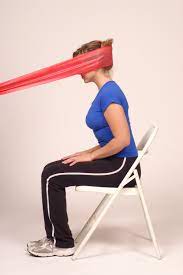
- First Place the theraband around a doorknob & tie a knot in the theraband & close it in the door.
- The band is at chest level.
- You are standing tall with each end of Theraband in your hands & the knee joint slightly bent, abdominal muscles tight.
- Must be Maintained the tight trunk muscles & then pull the arms back while squeezing the shoulder blades together or combined.
- You are trying to focus on squeezing the shoulder blades without shrugging the shoulder joint up towards the ears.
- Then return to starting position but Do not lean back.
- Hold this exercise position for 10 seconds.
- Perform the 10 times in 1 session & 3 sessions per day.
Head lifts
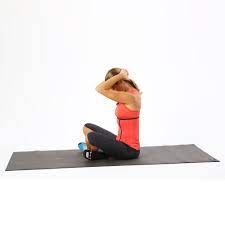
- You are Lie flat on the back with the arms stretched to the sides.
- Nod the head & tuck in the chin.
- Hold this exercise for a few seconds before releasing back to a neutral position.
- Hold this exercise position for 10 seconds.
- Perform the 10 times in 1 session & 3 sessions per day.
Seated Clasped Neck Stretch
- You are sitting comfortably on the floor & in a chair.
- Must place your body in proper alignment.
- Then Clasp your hands & bring both palms to the back of your head.
- Try to Gently press your hands down toward your thighs & tucking your chin into your chest.
- Hold this stretching position for 30 seconds.
- Perform the 3 times in 1 session & 3 sessions per day.
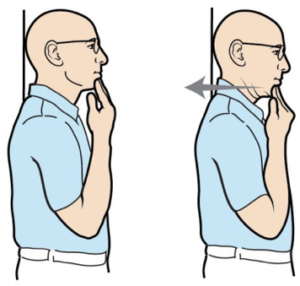
Chin tuck Exercise
- Sitting straight & look straight ahead with the ears parallel over the shoulders.
- Put two to three fingers on the chin.
- Stabilize the finger, pull the chin & head straight behind up to a gentle stretch is felt at the base of the head & top of the neck.
- Hold for 5 to 10 secs. Repeat seven to ten times.

Neck flexion Exercise (Neck tilt)
- In Relax sitting position flex the head down to rest the chin on the chest (Flex the neck fully).
- Gently tense the neck muscles & hold for 4 to 8 secs.
- Return to the initial position & repeat seven to ten times.
Neck extension exercise
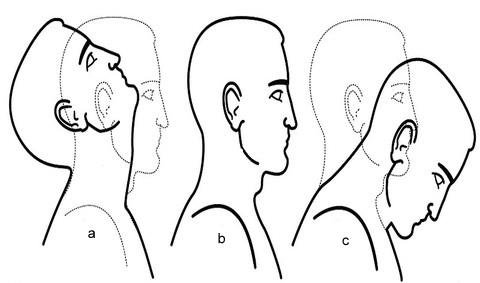
- In Relax sitting position without arching the back, slowly move the head backward so you are looking upward.
- Hold for 5 to 10 secs. Return to starting position.
- This is a good exercise to do during working hours to prevent neck strain.
- Gently tense the neck muscles & hold for 5 to 10 secs.
- Return to a neutral position & repeat 10 times.
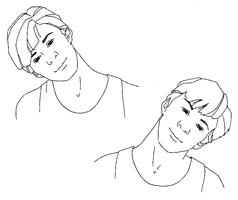
Neck flexion Exercise (side to side)
- Flex the head down towards the shoulder, & try to touch the shoulder with the ear (Without elevating the shoulder).
- Gently tense the neck muscles & hold for 8 secs.
- Return the head to a neutral position & repeat in the opposite direction.
- Repeat 10 times on both sides.
Neck Rotation exercise
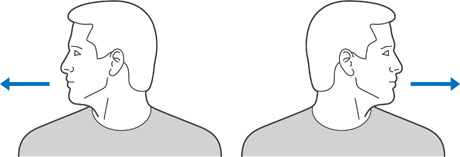
- Rotate the head towards 1 side, keeping the chin at the same level & moving within normal limits.
- Slowly stretch the neck muscles & hold for eight secs.
- Back the head to the neutral position & repeat in the other direction.
- Repeat 10 times on each side.
Revolved Triangle Exercise
- Stand with the feet about four feet apart.
- Face the right toes forward & the left toes out at a slight angle.
- Square the hips & face forward in the same direction the right toes are pointing.
- Lift the arms up at the sides so they are parallel to the floor.
- Slowly hinge at the hips to fold forward, stopping when the torso is parallel to the floor.
- Bring the left side hand to the leg, the floor, or a block, wherever you can reach.
- Extend the right side arm straight up with the palm facing away from the body.
- Turn the gaze to look up toward the right side thumb.
- Exhale to turn the neck to look down at the floor.
- Inhale as you return the gaze upward.
- Keep the rest of the body stable & continue these neck rotations as you stay in the pose for up to one min.
- Perform on the alternate side.
- Repeat 10 times on each side.
Upward Plank Exercise
- This pose allows you to passively hang the head back & down, releasing tension in the neck & shoulders. This lengthens & stretches the SCM, chest, & shoulder muscles.
- Make sure the back of the neck is fully relaxed to avoid compressing the spine. If it is uncomfortable for you to let the head hang back, you can tuck the chin into the chest & lengthen the back of the neck. Precise on engaging the neck muscles without straining.
- You can also allow the head to rest back on some type of support such as a chair, a wall, or stacked blocks.
- How to do- Come into a seated position with the legs straight in front of you.
- Press the palms to the floor alongside the hips.
- Lift the hips & bring the feet under the knees.
- Deepen the pose by straightening the legs.
- Open the chest and & let the head drop back.
- Hold for up to 30 secs.
- Do this pose up to three times.
Prone Cobra Exercise
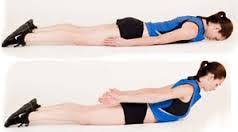
- This exercise is occur by lying face downwards on the ground & assist gravity as resistance in the reinforcing process.
- Lying face downwards on the floor, place the forehead on a rolled-up hand towel for support.
- Put the arms by the side, & palms downwards on the ground.
- Slide the tongue onto the upper palate of the mouth.
- Pinch the shoulder blades together & elevate the hands off the ground.
- Roll the elbows inwards, palms outwards, & thumbs upwards.
- slowly raise the forehead about an inch off the towel keeping the eyes looking ahead forward at the ground
- Hold the position for seven to ten secs.
- Do ten to fifteen reps.
Isometric Neck Exercise
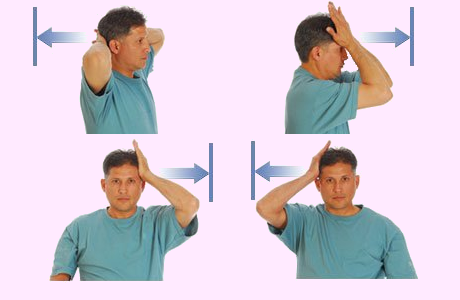
- Isometric neck exercises assist to strengthen the neck muscles. This exercise is mostly prescribed by Physiotherapists from day one to relieve Neck pain.
Isometric Neck Exercise
How to perform this exercise In a sitting alignment, - keep the Body steady and straight, Place both hands beside the neck (as seems in the images), & try the neck to push compress on the hands & At the same time Resist the neck muscles, both hands steady and align pattern for 4 to 5 secs & then relax.
- The first day does 8 reps & the 2nd day does 10 reps. Do some exercise on the forehead & each side of the neck.
- Do the exercise by compressing the side of the head. Repeat 8 times, then opposite sides.

Prone Rows Exercise
- Lie down on the stomach with the arms dangling off the side of the bed (just angling the body so the head is turning the corner of the bed).
- Use a pillow below the stomach for comfort. Start by pulling your arms back while bending elbows & contracting the shoulders blades together then gently back to the initial position.
- Do not raise your head up while pulling the arms back.
- Repeat twenty times. Perform two times a day.

Standing pushups exercise
- Stand about an arms-length down from the wall with the bases spread piecemeal.
- Place the hands on the wall, making sure that they parallel with the shoulders.
- Keeping the reverse straight, sluggishly bend or flex the elbows, bringing the upper body toward the wall.
- Extend the elbows & back to the initial position.
- Repeat fifteen to twenty times. Perform two times a day.
Lateral extension exercise

- Begins by looking forward ahead. Gently lean the head to the left side. Use the left side hand for resistance, and use the muscles in the neck to press against it. Hold for 5 to 10 secs, then return to the initial position.
- Then, slowly lean the head to the alternate side. Hold for 5 to 10 secs.
- Return to the initial position. Do 10 repetitions. This is a good exercise to do while in working hours, especially if you have to keep the head in a steady position for prolonged periods, as in working at a computer.
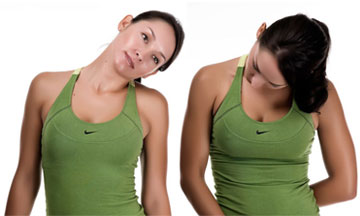
Tilted forward flexion exercise
- Sluggishly lean the head to the leftism. Using the left side hand for resistance, use the muscles in the neck to press against it. Hold for 5 to 10 secs, also return to starting position.
- Also, sluggishly lean the head to the other side. Hold for 5 to 10 secs.
- Return to starting position. Do 10 repetitions. This is a good exercise to do during work, especially if you have to keep the head in a steady position for a prolonged time as in working at a computer. Do this exercise every partial hour to help with the prevention of neck tightening.

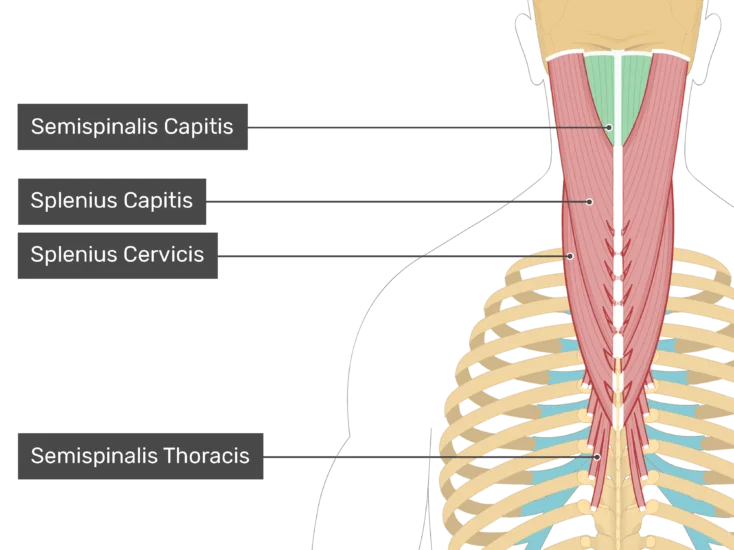
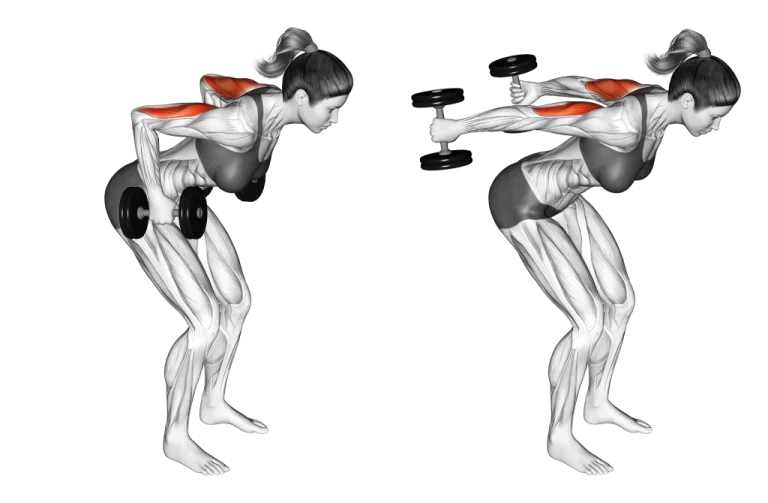
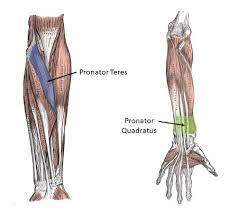

One Comment